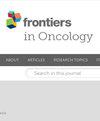Targeting non-coding RNAs to overcome osimertinib resistance in EGFR-mutated non-small cell lung cancer
IF 3.5
3区 医学
Q2 ONCOLOGY
引用次数: 0
Abstract
Osimertinib, a third-generation inhibitor of epidermal growth factor receptor (EGFR) tyrosine kinase, exhibits remarkable efficacy in prolonging the survival of patients with non-small cell lung cancer (NSCLC) carrying靶向非编码 RNA 克服表皮生长因子受体突变非小细胞肺癌的奥希替尼耐药性
奥希替尼是表皮生长因子受体(EGFR)酪氨酸激酶的第三代抑制剂,在延长携带EGFR突变的非小细胞肺癌(NSCLC)患者的生存期方面疗效显著,超过了第一代和第二代EGFR酪氨酸激酶的疗效。然而,奥希替尼耐药性的出现不可避免,因此有必要对其潜在机制进行研究。越来越多的证据表明,非编码RNA(ncRNA),包括microRNA、长ncRNA和环状RNA,在肺癌的发生和发展中起着重要作用。这些ncRNA调控着重要的信号通路,为了解奥希替尼耐药的基本机制提供了一条新途径。最近的研究报道了 ncRNAs 对奥希替尼耐药性的重大影响,这种影响是通过调节治疗敏感性的各种机制实现的。我们简要概述了已被广泛研究的 ncRNAs 在奥希替尼耐药发生过程中的功能和基本机制,并强调了它们在对奥希替尼耐药的表皮生长因子受体突变 NSCLC 中的潜在临床应用。最后,我们讨论了将基于 ncRNA 的方法有效转化为临床实践必须解决的障碍。
本文章由计算机程序翻译,如有差异,请以英文原文为准。
求助全文
约1分钟内获得全文
求助全文
来源期刊

Frontiers in Oncology
Biochemistry, Genetics and Molecular Biology-Cancer Research
CiteScore
6.20
自引率
10.60%
发文量
6641
审稿时长
14 weeks
期刊介绍:
Cancer Imaging and Diagnosis is dedicated to the publication of results from clinical and research studies applied to cancer diagnosis and treatment. The section aims to publish studies from the entire field of cancer imaging: results from routine use of clinical imaging in both radiology and nuclear medicine, results from clinical trials, experimental molecular imaging in humans and small animals, research on new contrast agents in CT, MRI, ultrasound, publication of new technical applications and processing algorithms to improve the standardization of quantitative imaging and image guided interventions for the diagnosis and treatment of cancer.
 求助内容:
求助内容: 应助结果提醒方式:
应助结果提醒方式:


